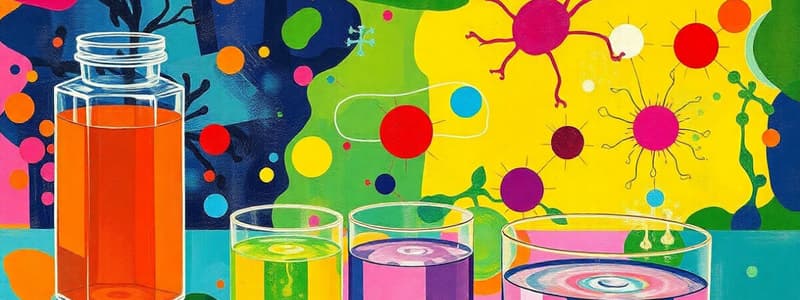Podcast
Questions and Answers
What is the first step in isolating pathogens from infected lesions?
What is the first step in isolating pathogens from infected lesions?
How long should the sections be surface sterilized before plating them on the nutrient medium?
How long should the sections be surface sterilized before plating them on the nutrient medium?
What is the purpose of washing the surface sterilized sections in sterile water?
What is the purpose of washing the surface sterilized sections in sterile water?
In the serial dilution method, what is done to the sections of diseased tissues after surface sterilization?
In the serial dilution method, what is done to the sections of diseased tissues after surface sterilization?
Signup and view all the answers
What is used to identify pathogenic bacteria after performing serial dilutions?
What is used to identify pathogenic bacteria after performing serial dilutions?
Signup and view all the answers
What type of sterilant is most commonly used for leaf dips to prepare infected plant tissues?
What type of sterilant is most commonly used for leaf dips to prepare infected plant tissues?
Signup and view all the answers
Which culture media is primarily recommended for growing most types of fungi?
Which culture media is primarily recommended for growing most types of fungi?
Signup and view all the answers
What is the first step in preparing for the isolation of fungal and bacterial pathogens?
What is the first step in preparing for the isolation of fungal and bacterial pathogens?
Signup and view all the answers
To inhibit the growth of bacteria when culturing fungi, which substance can be added to the medium?
To inhibit the growth of bacteria when culturing fungi, which substance can be added to the medium?
Signup and view all the answers
What should be done to the work table before beginning the pouring of culture media?
What should be done to the work table before beginning the pouring of culture media?
Signup and view all the answers
Which type of culture media is particularly useful for isolating bacterial plant pathogens?
Which type of culture media is particularly useful for isolating bacterial plant pathogens?
Signup and view all the answers
What is the minimum duration for dipping infected tissues in a 70 per cent ethyl alcohol solution?
What is the minimum duration for dipping infected tissues in a 70 per cent ethyl alcohol solution?
Signup and view all the answers
When should hands and tools be cleaned and sterilized during the isolation process?
When should hands and tools be cleaned and sterilized during the isolation process?
Signup and view all the answers
Study Notes
Preparing for Isolation
- Sterilized Glassware: Petri dishes, test tubes, and pipettes are essential for isolating fungal and bacterial plant pathogens.
- Surface Sterilants: 70% ethyl alcohol is generally used to eliminate surface contaminants from infected plant tissue. Leaf dips for 3 seconds or more are standard practice.
- Culture Media:
- Potato Dextrose Agar (PDA): Suitable for most fungi.
- Water Agar or Glucose Agar: Used for separating certain oomycetes (Pythium) and fungi (Fusarium) from bacteria.
- V-8 Agar: Encourages fungal sporulation.
- Nutrient Agar: Contains beef extract and peptone, suitable for isolating bacterial plant pathogens.
- Lactic Acid: Adding 1-2 drops of a 25% lactic acid solution to 10 ml of culture media inhibits bacterial growth, enabling easier isolation of fungi.
- Pouring Plates: Sterilized culture media is poured into sterile petri dishes, test tubes, or other containers. Aseptic techniques are crucial to prevent contamination. Working in a laminar flow hood minimizes airborne contaminants.
Methods of Isolation
- Plant Pathogen Isolation: The isolation method depends on the pathogen's nature, its presence within host cells, and its form.
Isolating Pathogens from Leaves
Fungi
- Sectioning: Small sections (5-10 mm square) are cut from the margin of infected leaf tissue. Sections should include both diseased and healthy tissue.
- Surface Sterilization: Sections are immersed in surface sterilant solution for 15 to 30 seconds.
- Washing: Sterilized sections are washed in three changes of sterile water.
- Plating: Sections are blotted dry and placed onto nutrient media (PDA).
- Incubation: Petri dishes are incubated at 25°C for 3-5 days.
- Fruiting Structures: If pycnidia or perithecia are present, they can be directly plated on nutrient media after a brief surface sterilization.
Bacteria
- Serial Dilution Method: This method separates pathogenic bacteria from diseased tissue contaminated with other bacteria.
- Homogenization: Diseased tissue sections are ground aseptically in sterile water, creating a homogenate.
- Serial Dilution: The homogenate is diluted serially in sterile water.
- Plating: Plates containing nutrient agar are streaked with dilutions to isolate single colonies of the pathogenic bacterium.
Studying That Suits You
Use AI to generate personalized quizzes and flashcards to suit your learning preferences.
Related Documents
Description
This quiz covers essential methods and materials for isolating fungal and bacterial plant pathogens. Topics include the use of various culture media, surface sterilants, and sterilized glassware. Test your knowledge on the techniques essential for successful plant pathogen isolation.




